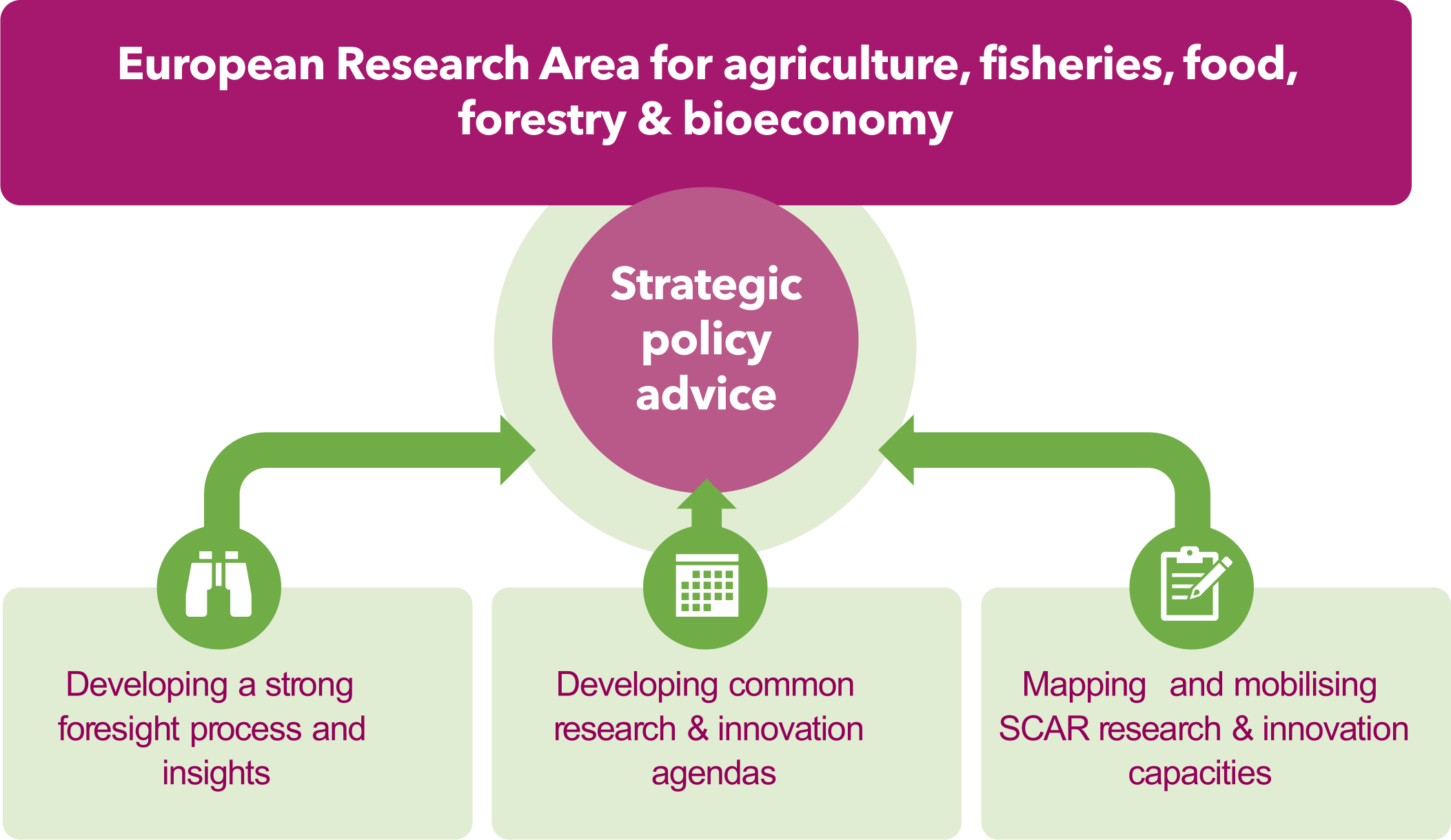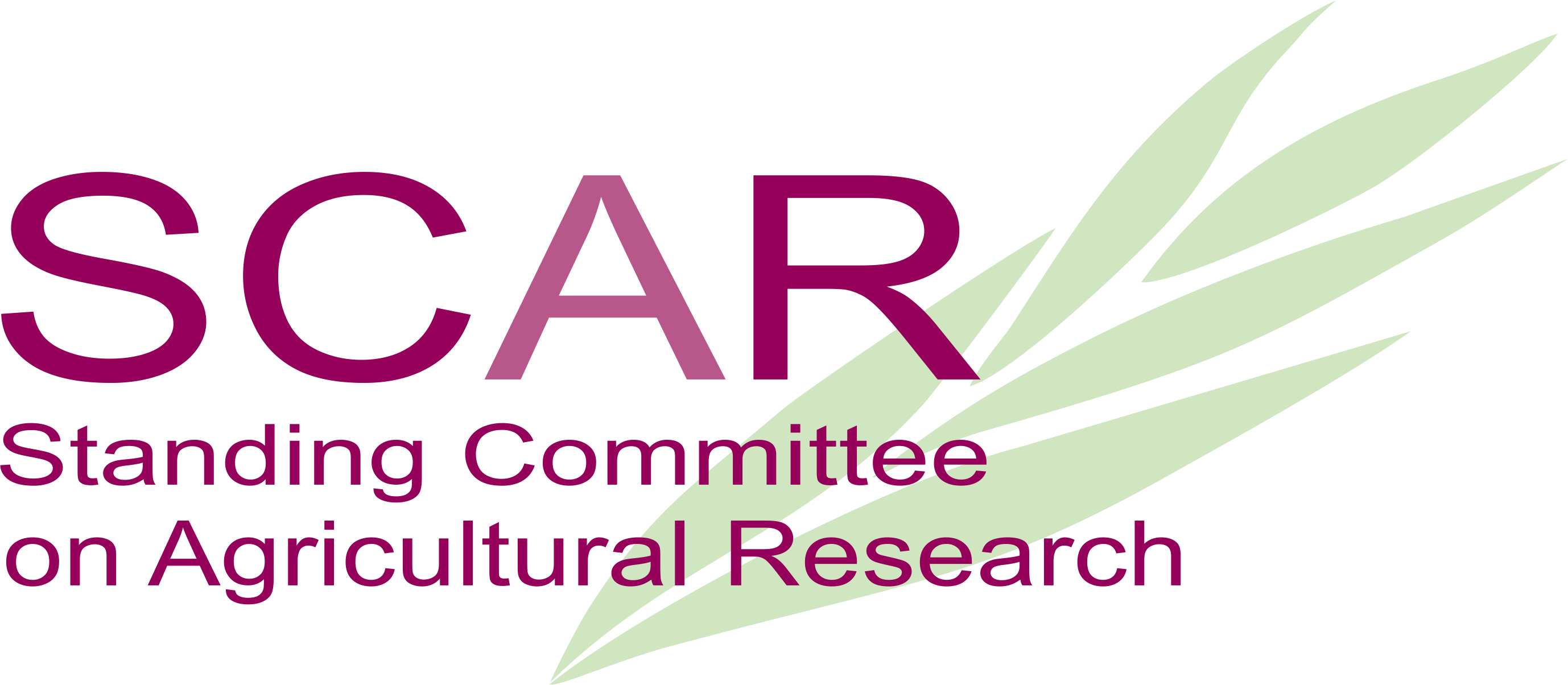AGROECOLOGY | AKIS | ARCH | BIOECONOMY | FISH | FOOD SYSTEMS | FOREST |
SCAR Operations and Achievements
SCAR plays an important role in establishing a European Research Area with a common agricultural and wider bioeconomy research agenda including fisheries (SCAR Fish), which enhances cooperation, coordination, and information exchange between the Member States using four main activities:

Strategic Policy Advice
Through all its activities and with its various instruments, SCAR’s most essential output is research and innovation related policy advice. In forming the advice the increasing role of Strategic Working Groups and Joint Programming Initiatives can be traced. Examples include:
- Supporting development of European initiatives such as the Joint Programming Initiative process and the Horizon 2020 programme and its work programmes along with development and strategic input to the national programme coordination mechanism ERA-Net Co-fund;
- SCAR Agriculture Knowledge and Innovation Systems (AKIS) Strategic Working Group has produced two influential reports that develop our knowledge and understanding of innovation systems in Europe, focusing on the organisation of AKIS in Member States and regions and the incentives driving the AKIS subsystems, along with members’ experiences with interactive innovation and the related policy instruments. The group has been instrumental in the development of the European Innovation Partnership-AGRI (EIP-AGRI) and from a very early stage, the Commission has involved SCAR in the strategic development of the innovation chapter in the Common Agricultural Policy to be implemented through the EIP-AGRI;
- Helping to evolve the bioeconomy through SCAR Working Groups such as the Strategic Working Group on Sustainable Biomass and the Collaborative Working Group on Integrated Biorefineries, bringing together key players in the field and jointly producing relevant policy output;
- Contributing to global food security through SCAR activities. Especially notable is the SCAR/EIARD ARCH group bringing together the different worlds and goals of European agricultural research and official development aid;
- Contributions to Fish and Aquaculture and Forestry.
Developing a strong foresight process
To cope with the wide range of complex and interlinked challenges facing agriculture and the wider bioeconomy the use of foresight is important in ensuring that the right research questions are asked. Strongly encouraged by the EU Council, SCAR has launched four separate foresight exercises since 2005 which have identified possible futures scenarios for European agriculture as the basis for prioritising research and other activities in the medium to long term. Each foresight report has been accompanied by a dedicated conference aimed at disseminating results and providing a platform for discussing the key foresight messages. Foresight conclusions and recommendations have been used by the Commission and MS/AC in planning research coordination activities.
| SCAR Foresight Process | ||
| 2006-7 | 1st Foresight Exercise - Disruption Scenarions Towards future challenges of Agricultural Research in Europe - Key messages for research priority setting |
CWG Agriculture & Climate Change JPI FACCE and HDHL CWG Agriculture & Energy |
| 2008-9 | 2nd Foresight Exercise - Resilience and Crisis Sustainable development - a challenge for European Research |
AKIS EIP-A |
| 2010-11 | 3rd Foresight Exercise - Productivity and Sufficiency Transition towards sustainable food consumption and production in a resource constrained world |
SWG Forest R&I SWG Sustainable Biomass SCAR-Fish |
| 2014-15 | 4th Foresight Exercise - Sustainable Agriculture, Forestry and Fisheries in the Bioeconomy | Infographic poster |
Developing common research agendas
Since 2005, more than 20 CWGs/SWGs have been set up by European countries engaging voluntarily and on a variable-geometry basis in the definition, development and implementation of common research agendas based on a common vision of how to address major challenges in the field of agricultural research.
The dynamism and commitment of several CWGs paved the way for participation in the FP7 ERA-NET scheme. Eight of them became ERA-NETs.
In the same logic as for ERANETs, SCAR has been highly active and influential in the Joint Programming process proposed by the European Commission in 2008 to further promote research alignment and common agendas. In 2010 the Commission adopted two recommendations for Joint Programming Initiatives: "Agriculture, Food Security and Climate Change" (FACCE) and "A Healthy Diet for a Healthy Life" (HDHL), both of which were underpinned by SCAR activities. FACCE and HDHL have since adopted their Strategic Research Agenda (SRA) in 2011 and 2012 respectively and have provided a framework for the alignment of existing programmes and joint research efforts to achieve the objectives of their respective areas.
Mapping SCAR research capacities
Preliminary to any potential joint activity, an adequate mutual knowledge of activities, institutions and facilities in Member States and Associated Countries is needed. SCAR agreed that mapping activities should be carried out by building on the EU AGRI-MAPPING project from the FP6 SSP-4 call “Mapping and foresight of the EU agricultural research capacity”. A project was negotiated in cooperation with SCAR towards the delivery of a mapping report on European capacities in the field of agricultural research and recommendations on development that would be desirable in the enlarged Europe by 2020.
In 2008, SCAR established the Collaborative Working Group (CWG) on 'Shared Infrastructures for European Agri-Food Research' to bring about increased collaboration between Member States and Associated Countries, exploit potential synergies, look for efficiency gains, eliminate redundancies, and make budgetary savings through the eventual sharing of EU infrastructures. The group provided a comprehensive analysis of short-comings, gaps, obstacles and needs and suggested possible solutions and approaches for overcoming existing difficulties for addressing future challenges.
In addition to these initiatives most of the CWGs and ERA-Nets have carried out their own sector driven mapping exercises which are essential to formulating eventual joint programming exercises. These mapping exercises need to evolve into more dynamic and analytical real time interactive approaches which can engage the right stakeholders and demonstrate palpable follow-up leading to a better alignment of national programmes and gap analysis.


